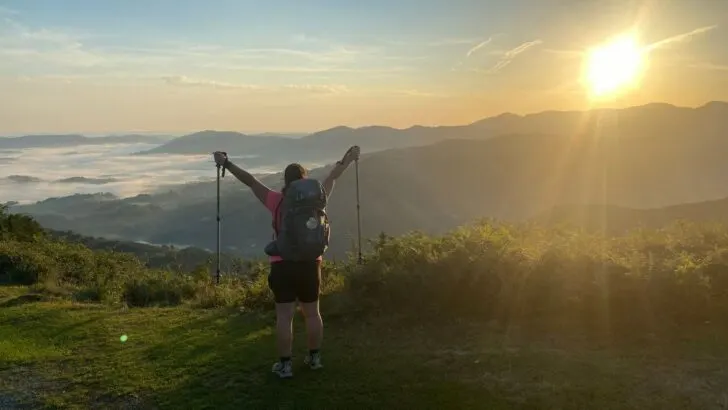There is no shortage of information about walking the Camino online. In fact, there’s so much out there that it can become quite daunting knowing where to focus your attention! When is the best time to walk the Camino? Is doing it solo the best idea? Is training required? Are hostels the only option? What shoes are needed? What is an albergue? What does Buen Camino mean? It means good way and you say it to passing pilgrims while on your journey.
The questions are endless and you will most likely have even more once you start walking. It’s all a part of the journey so I encourage you to drop any expectations of figuring it all out before you take your first steps on the Camino.
That being said, preparation can help a ton!
I believe that having even an inkling of a desire to walk to Camino is reason enough to do it. And I want to help you find your footing with as little confusion as possible.
This article will be packed with resources I personally used (and were actually helpful), common questions for first-time pilgrims, books I loved, and personal anecdotes of my time walking. While I believe a lot of this information can be applied to any Camino pilgrimage, I personally walked the Camino Frances from St. Jean Pied du Port starting in late August.
Let’s dig in.
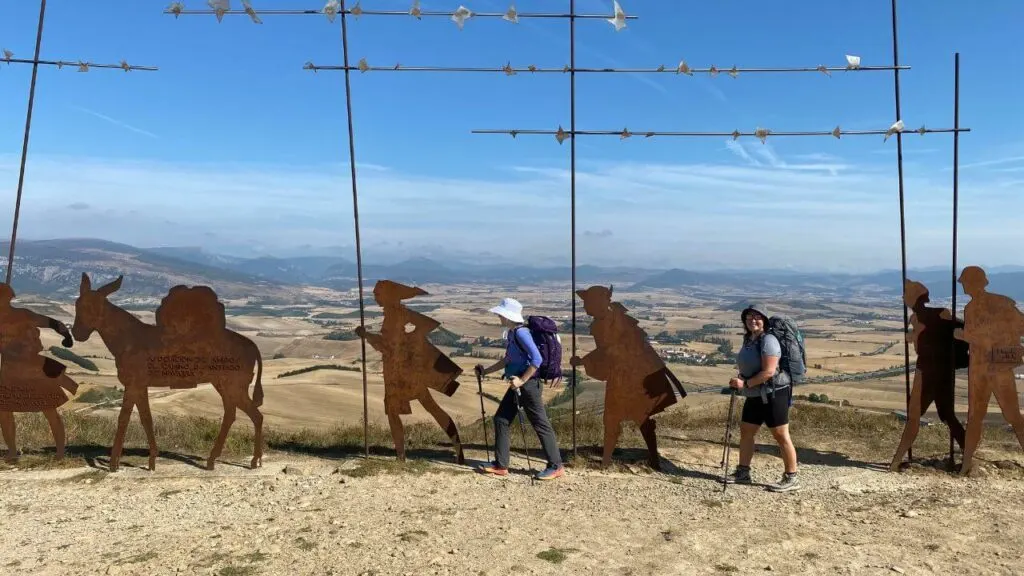
What is the Camino, exactly? And why is it so popular?
To put it simply, it’s a pilgrimage! A pilgrimage is a journey that an individual embarks on in order to find meaning (or a deeper meaning) in themselves, a higher power, nature, or connections with others. Today many walk the Camino for these reasons, but also for the physical feat it is to walk 100km+.
The Camino de Santiago specifically dates back to Medieval times, when followers of the Christian religion walked in what they believed were the footsteps of St. James (otherwise known as James the Great), one of the 12 apostles of Jesus Christ. The church (Santiago de Compostela Cathedral) which is the official end of the Camino de Santiago in the city of Santiago de Compostela, Spain is said to hold the remains of St. James.
In English, you may hear it called the Way of St. James, or from German-speaking or Scandinavian countries, Jacob’s Way.
Though an ancient walking route, the Camino de Santiago really surged in popularity in the early 90s due to efforts from tourism boards and dedicated individuals to the Camino. In 1993 the route was declared a UNESCO World Heritage site. Additional interest and popularity grew when the movie The Way starring Martin Sheen was released in 2010.
Do you have to be Catholic (or religious) to walk the Camino?
The short answer is no! The beauty of the Camino is that anyone can walk it, regardless of religion or beliefs. I wondered how religious it was going to be when I first started researching this trip and was pleasantly surprised by the diversity of pilgrims when I was en route to Santiago.
The churches along the way are open to all who wish to sit in and participate or witness, but it is absolutely not mandatory to be Christian. The majority of the people who walk the Camino, in my experience, were very open. There were a few who challenged why my friend and I would choose to do a pilgrimage related to Christianity if weren’t religious, but they ended up being fascinating debates that most certainly widened my perspective (and I hope theirs too!).
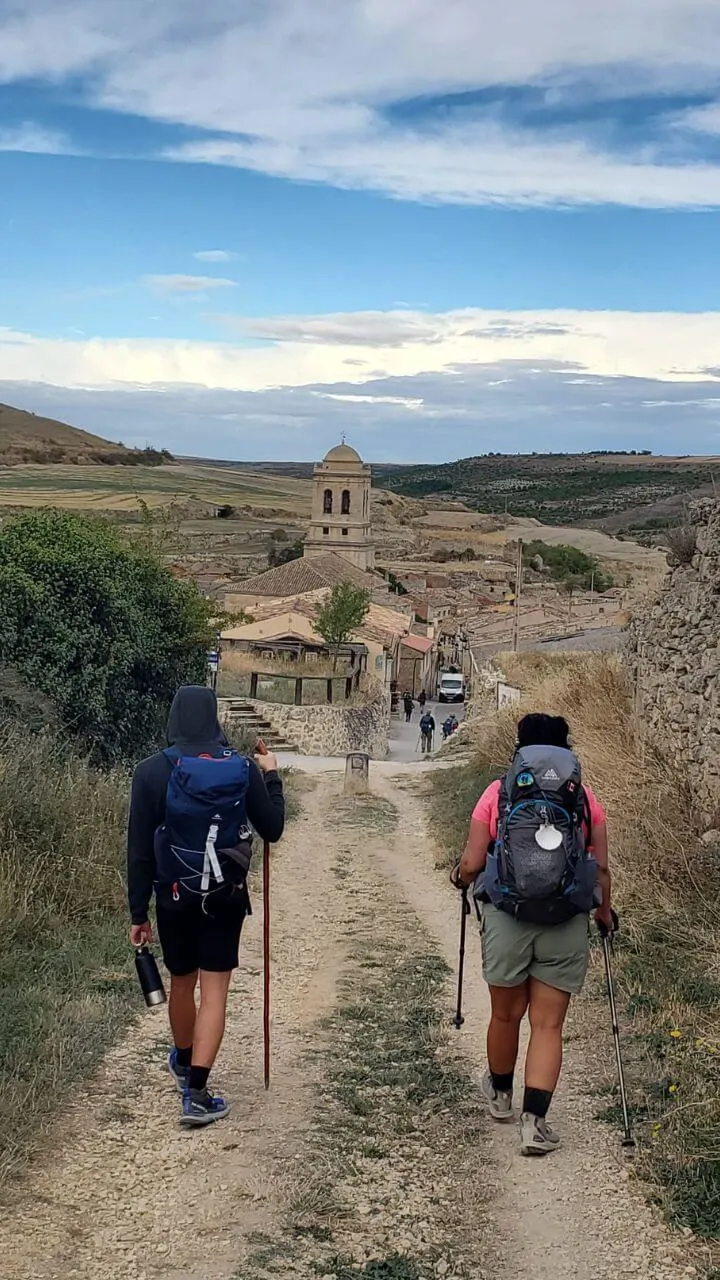
To Camino solo, or not Camino solo?
Perhaps one of the most common debates is whether or not to walk the Camino solo. This trip is the first of its kind for many. Some it’s their first international trip ever. Others know instantly that it is something that must be done alone. And while you may instinctively feel one way, it’s not difficult to let others sway your judgment amongst Camino groups on Facebook and forums.
Let me be clear about one thing first: the Camino is safe to walk solo.
Thousands of people do it every season and while no area of the world is completely free of crime, the Camino has to be one of the safest, if not the safest destination I’ve ever travelled to (I have been to 40 countries, 20 of which were solo). The Spanish are very passionate about the Camino and protecting the pilgrims. So much so, that there are even Camino police who patrol the routes! So please, don’t let safety be your reason for not walking solo if that’s what you’re debating.
If you’re worried about being alone or getting lonely, walk one of the most popular routes (see more on that below). If you want to be alone, choose your route carefully. Regardless of which route to choose to walk, expect to be lonely at points. This is part of the journey and will provide great insights.
Personally, I walked with a good friend from college who I had travelled with before, though neither of us had ever done anything like the Camino in previous travels. I loved knowing that someone I knew was close by, but for the most part, I wanted my time walking mostly to myself.
I felt that walking with a friend felt suffocating at times, but also adored the comfort of sharing the experience with someone. If you choose to walk with someone or a group I would highly recommend having a conversation before you go on what your expectations are for time together and apart. Then check in periodically throughout your trip as you evolve. I promise there will be times when you don’t want to see another soul, and times when you want to be at the biggest table for dinner.
It’s really hard to know how you will feel while on the Camino, and it changes plenty while walking as well. I chose to walk the Camino more so for personal growth and to see if I could connect with something more spiritual over than physical aspect. This meant that I needed a lot of time in silence to contemplate big questions I had for myself and for the Universe.
At other times I wanted nothing more than to chit-chat with my friend about old college stories or complain about the blisters on my heels.
Walking with a friend or a group I believe can be more challenging than walking solo.
When you are solo it’s easier for you to sneak away or match your step to another pilgrim’s pace to chat. Complete strangers will talk to you, you will not be seen as weird for talking to people randomly.
Whichever way to choose to walk, solo, or with someone is the right choice for you. I do encourage you to push yourself out of your comfort zone and see what’s on the other side. It’s a very eye-opening experience.
For context, I have travelled more solo than I have with other people, so walking with someone was both comforting and also a huge learning curve that I was unfortunately not always graceful while dealing with it. But I am grateful for the lessons that came from it.
My friend and I also met so many people and we even ended up walking with two ladies who were walking solo to create a little group that dispersed and came together across the entire trip. People will come and go on your trip, but one thing is for sure: you will never be truly alone while walking the Camino.
Walk with a Group: Camino Tours
You also have the option to have pretty much everything taken care of for you by joining a Camino walking holiday. Some great options include:
- Full Spanish Camino (36 days)
- Walk the Last 100km (8 days)
- Walking the Camino + Madrid (12 days)
Find Your Way: Camino de Santiago Routes
There are multiple Camino routes. Quite literally, all roads lead to Santiago. There are 7 common Camino de Santiago routes, which are:
- Camino Frances (French Way)
- Camino Portuguese (Portuguese Way)
- Camino del Norte (Northern Way)
- Camino Primivito (Original Way)
- Via de la Plata (Silver Way)
- Camino Ingles (English Way)
- Camino Finisterre-Muxía
Camino Frances is by far the most popular route, followed by the Camino Portuguese. I personally chose to walk the Camino Frances for my first walk because it has the most facilities. I felt the most comfortable knowing that, and that lots of other people would be walking it too.
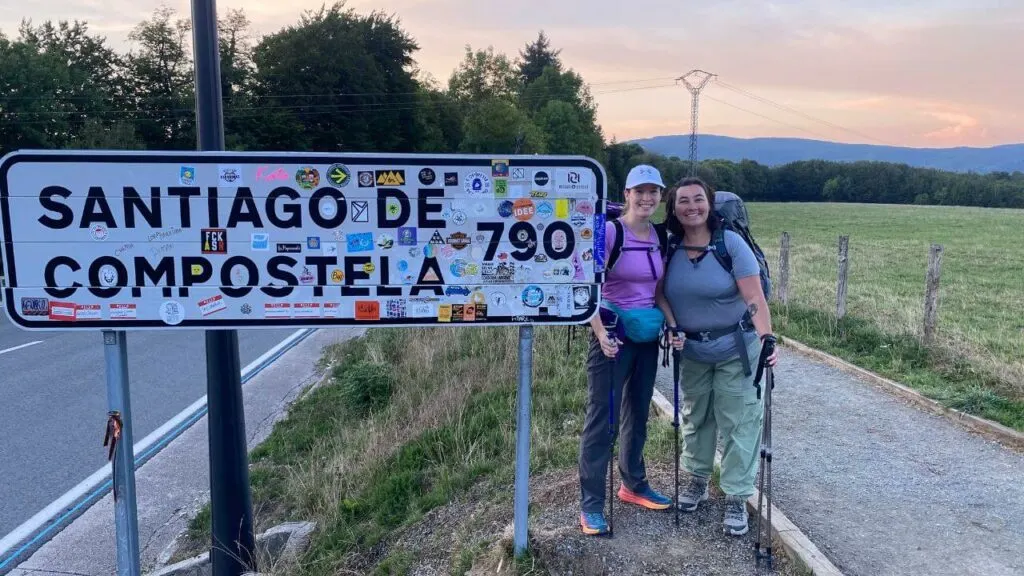
How to Choose the Best Camino Route for You
The route that is best for you is based on how many people you’d like to be around, what time of year you are available, and how much time you have. Each route has its perks and downfalls which can include heavy foot traffic, not-so-great weather, and easy or difficult terrain and elevation.
Another factor is what you want to see. There are coastal routes available (Northern and Portuguese Ways), and others that feature mountains, rolling hills, and farm fields such as the Camino Frances.
The distance and time you have plays a big factor but know that even though some of these routes are labelled as 300km+, you can always start your route closer to Santiago. It’s not uncommon for people to walk sections of the larger routes and come back year after year to complete the next section.
The best time to walk the Camino de Santiago and how long it takes to walk the Camino are both major factors. Some routes do not have albergues (hostels) or other accommodations open year-round. Some do, however, options may be limited.
Camino Frances
- Distance: 790km
- Best for: First-time pilgrims, scenery
- Time commitment: Approx. 30 days (I did 39 days)
- Difficulty: Moderate (mostly) with occasional difficult areas
Do yourself a favour and avoid the summer months of July and August if at all possible. Spanish heat does not mess around. May-June and September-October are the best times to walk this popular route with a huge uptick in pilgrims beginning in September. For this reason, my friend and I opted to start August 28th to avoid the rush of traffic and it paid off as a massive wave of people made it more difficult to book accommodation just behind us.
Some will recommend beginning in late April to avoid the May rush, however, it is weather dependent this time of the year which is especially important for those crossing through the Pyrenees Mountains. This will be you if you opt to walk from the beginning of the Camino Frances, St. Jean Pied du Port.
Camino Frances is often said to have the best views, and honestly, I can’t deny that walking through the Pyrenees Mountains was absolutely the most scenic part and well worth all the uphill.
Camino Portuguese
- Distance: 616km from Lisbon, or 260km from Porto
- Best for: First-time pilgrims, culture (central route), ocean (coastal route)
- Time commitment: Approx. 25 days from Lisbon, 14 days from Porto
- Difficulty: Moderate from Porto, difficult from Lisbon
This route is commonly started in both Lisbon and Porto, so depending on where you decide to begin will determine when you can walk to beat the heat. Generally, you are safe from dreaded temperatures by the end of April until July, and in September and October. Avoid August unless you choose to start from Porto.
Note that there are different paths on this route. You can opt to stay on the central route and pass through amazing towns and cities for more of a cultural trip, or head to the coast for beaches and magnificent scenery.
Camino del Norte
- Distance: 825km
- Best for: Coastal scenery, less traffic alternative to Camino Frances
- Time commitment: Approx. 30 days
- Difficulty: Difficult
July and August will be the busiest months on this route, but you’ll also have great beach weather as this route follows the northern coast of Spain. June and September, the shoulder months will have less foot traffic and not as hot weather.
Fellow pilgrims have described this route to me as very hilly with lots of ups and downs and mud. But you will pass through magnificent beach towns and have access to plenty of beaches to cool off at.
Camino Primitivo
- Distance: 321km
- Best for: Off-the-beaten-track
- Time commitment: Approx. 14 days
- Difficulty: Difficult
Weather can be unpredictable on this Camino route as it jaunts over plenty of hills and mountains. Don’t let its proximity to Camino Frances fool you, it is a very different experience! Best stick to walking the Camino Primitivo between June and August.
Camino Ingles
- Distance: 116km
- Best for: “Taste” of the Camino, first-time pilgrims
- Time commitment: Approx. 5 days
- Difficulty: Moderate
This Camino takes you through the lush and beautiful landscapes of Galicia. Walking through this region of Spain made me feel like I was in Scotland, and with unpredictable weather, it kinda felt like I was! You can expect rain anytime here with the most popular months to walk Camino Ingles being June to September.
I describe this route as a taste of the Camino because it’s common for people to walk this route to test if the Camino is a good idea for them without making a major time commitment.
Via de la Plata
- Distance: 1000km
- Best for: Seasoned pilgrims
- Time commitment: Approx. 45 days
- Difficulty: Difficult
Protect yourself from the Spanish heat once again, and avoid the peak of it in July and August. Opt for mid-late spring, April and May. You may catch some luck walking in September but expect high temperatures until October.
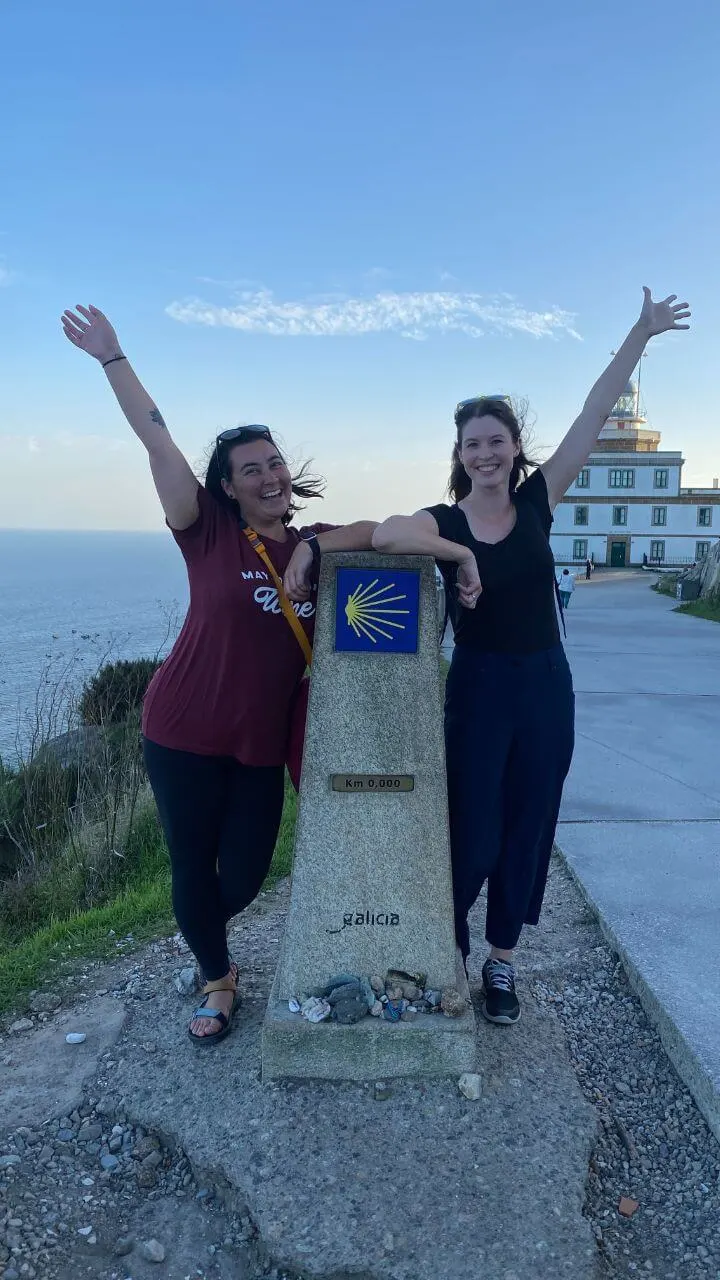
Camino Finesterre-Muxia
- Distance: up to 115km
- Best for: Land and sea views, Camino extension
- Time commitment: Approx. 4 days
- Difficulty: Easy
While technically an extension of the Camino, this route is the only walk that leaves from Santiago de Compostela! It will take you to the towns of Finisterre which translates to the end of the earth and/or Muxia (it’s a loop). There is quite a bit of shade on this walk so anytime from June-September can work. I did most of the walk to Finisterre (I got food poisoning) in October and it was lovely.
Note that you can also choose to walk only to Finisterre or only to Muxia. Finisterre has the 0km stone marker and is a lovely town to spend a night or two in to celebrate completing the Camino in a relaxing atmosphere.
When to Start Planning to Walk the Camino
You can begin planning as early as a year out, which is what my friend and I did. Planning to walk the Camino can take a lot of research if you’re a big planner, or it can take a little if you choose a more live-in-the-moment approach.
We opted to know our general route and distances each day before we left but adjusted as we went along. We booked our accommodation 2-3 days out on average, but some we booked ahead when we knew we were headed to busy places such as cities or the last 100km from Sarria to Santiago de Compostela.
Some pilgrims chose to not know where they were going to sleep the night of, and wander into an albergue in hopes of a free bed. To each their own!
If you plan in advance, this will also give you ample time to collect all of the gear you will need to walk. While the “right” gear is not necessary, there are certainly some items you will want to get specifically for this trip such as proper hiking boots or shoes, Merino wool socks, and breathable underwear, to name a few.
Planning 4-6 months out is plenty, and any time before is additional but can really help get you into the Camino spirit (which I highly recommend!). Planning early also means that you can shop sales for gear, book albergues that are known for selling out early (like those in the Pyrenees Mountains), and train extra early, if desired.
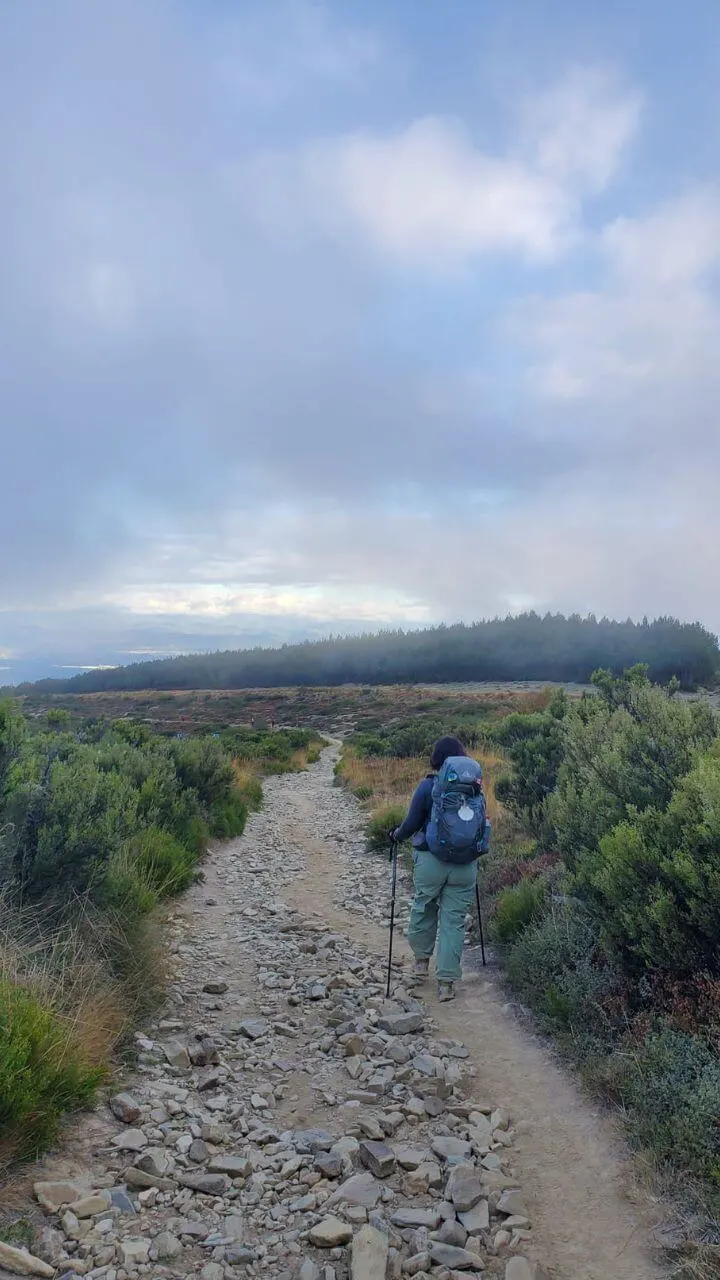
How far do you walk each day on the Camino?
The average day on the Camino will be 20-25km. I found this to be true. My shortest day was just under 8km, which my friend and I chose to do to ease ourselves into it and to experience staying at the lovely Refuge Orisson. My longest day was just under 38km (which I did not wish to repeat), which I did to challenge myself and get to a specific albergue with yoga that was said to be like a little oasis (it was). Albergue Verde.
My friend and I chose a rather leisurely pace, opting to finish in 39 days which is longer than typical. This allowed us to walk your average days, with some shorter and 4 rest days. This was a choice we made because we love cities and wanted to spend time sightseeing (and eating delicious Spanish dishes) in Pamplona, Logroño, Burgos, and Leon.
Do you need to train for the Camino de Santiago?
Yes. The average person I would say requires some training for the Camino. Do you have to? No. I do recommend training as it will help ease your transition into walking long distances daily and most likely cut down on some of the soreness!
I know there are training plans out there that can seem quite intense, but they are just recommendations. I personally started training 3 months (12 weeks) out, 3 times a week. I am a regular walker to begin with, walking about 2-3km per day for fresh air. But I began upping my walks to 5km right away and added a km or two to each walk per week.
The longest training walk I did was 14km and the longest training walk I did with my pack was 8km a week before I left. I highly recommend doing at least one training walk with your pack to make sure it fits okay. My poor friend had issues with her pack the first day as it wasn’t sitting right on her and caused back major back pain! Luckily she sorted it out before day 2, but if you can avoid it (especially when hiking through the Pyrenees Mountains), it’s best to.
I did not train with my poles and walked with them for the first time on the first day of the Camino. They are very easy to get used to and I highly recommend that you use poles.
General leg and ab training can also be beneficial but is not necessary. Just wait until you see how quickly you get strong once walking!
Where do you stay on the Camino?
- Budget: Albergues
- Mid-range: Guesthouses
- Luxury: Hotels & Paradores
The most popular and traditional Camino de Santiago accommodation option are albergues which are hostels. These are specific for pilgrims and can vary significantly with rooms being as small as two beds, and up to 100! As a walking pilgrim you will be accommodated to first. Pilgrims who choose to bike are not allowed at some albergues all together and albergues are not open to the public.
Albergues can be anything from people’s homes to converted monasteries. I’ve even seen an albergue that had no power, which I opted to not stay in because I was craving a hot shower far too much.
There are two kinds of albergues: private and public. Public (municipal) albergues are typically owned and operated by the town and are the cheapest option, with some being donation based. Public albergues can’t be booked in advance and are on a first-come-first-serve basis.
Private albergues are where I stayed mostly as the rooms tend to have fewer beds (so less of a chance of snorers). They are usually a few euros more expensive but well worth the splurge in my opinion. They are owned and operated by locals or a company and many can be booked in advance. Some can be booked through sites such as Booking.com, others directly on their websites, some require you to message them on Whatsapp.
Guesthouses may also be called Casa rurales or pensiones. These are a great option for nights when you need a private room for your sanity as they are more budget-friendly than hotels and also more common along Camino routes. You will get your own room and sometimes a private bathroom, sometimes a shared bathroom with another room or few. These tend to be locally owned.
For a dose of luxury you could treat yourself to a Parador, a hotel in a historic building. This type of hotel oozes luxury, with the most iconic of them all facing the church in Santigo de Compostela where you will finish your journey, Parador de Santiago – Hostal dos Reis Catolicos. The Parador in Leon is drop-dead gorgeous too, Parador de Turismo Leon. There are other hotel options along the Camino routes as well but are limited to larger stops or cities. If you want to stay in a Parador book in advance to avoid disappointment.
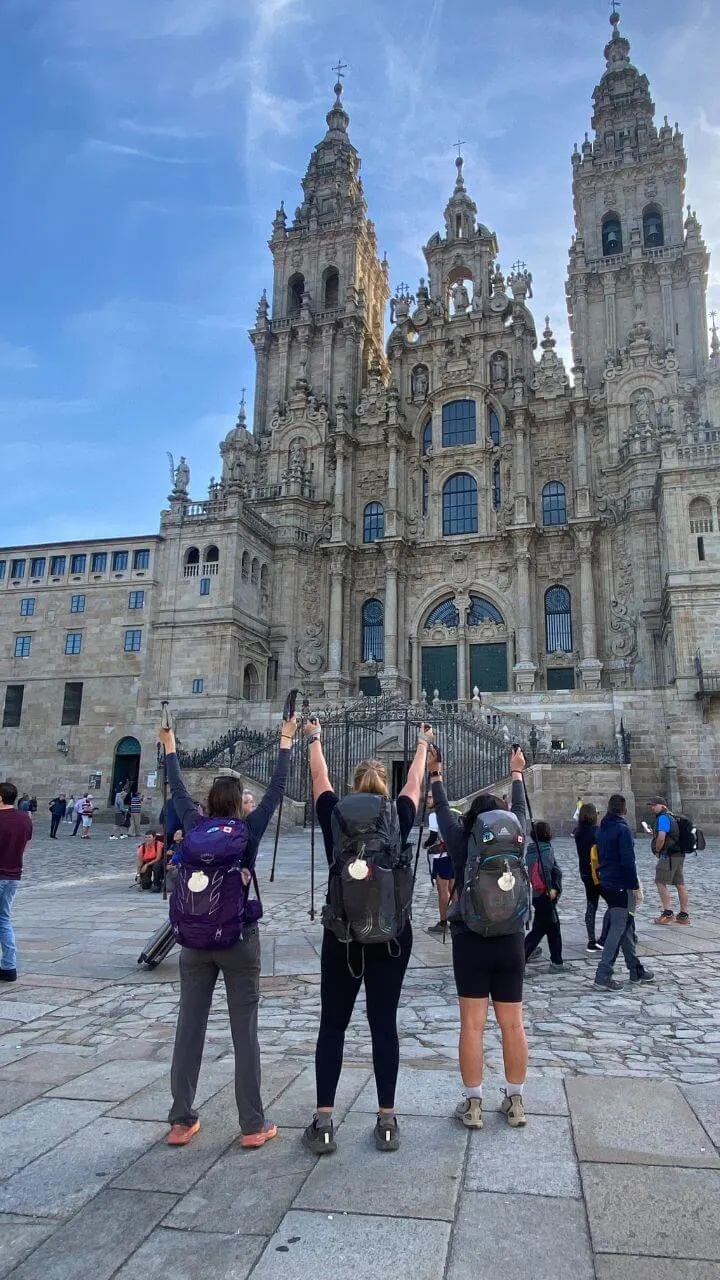
My Journey Walking the Camino & Would I Walk it Again?
As I was walking the Camino I was dumbfounded by how many people I met who were walking the Camino again for a second, third, some even a ninth time! As my feet pounded the pavement and I winced as I could feel skin pulling off the blisters on my heels, I couldn’t fathom why someone would choose to walk the Camino again. Surely, once is enough?
By the end of my Camino with 800km+ behind people were asking me and my friend if we’d ever walk again. We stole a line from another pilgrim we met and responded with, “Ask me again in 10 years.” At that point, I didn’t have a single desire to put myself through the exhaustion of trudging so far on foot again, no matter how profound the physical feat was.
But now, not even a year after completing my first Camino I already have my eyes set on my next – and with the same friend!
So yes, I will absolutely walk the Camino again and I can envision myself walking all of them. The Camino has impacted me tremendously and I see it as a spiritual journey to keep me grounded, to reset, and to cherish.
I approached the Camino as much a spiritual journey as I did one to find a deeper sense of connection with myself. I wanted to walk it to prove to myself that I could do something so physically challenging, yes, but I also wanted to challenge myself mentally. I too wanted to feel more connected to the divine, whatever you may call it, and find myself more in touch with something so that I could feel more whole.
I left for the Camino with questions about what to do with my business – should I pivot from travel to yoga? And if I did, did I really want to? I felt like I didn’t have much of a community where I lived, and experienced a lot of anxiety in my day-to-day life, feeling restricted by time and always feeling like I had too much to do. So I went to the Camino with the plan to fully disengage from my business and any type of social media. I deleted all the apps, let my site run on autopilot, got my yoga classes covered, and declined getting a SIM card once in Spain. I was armed with a journal to document my trip and sort through my thoughts, my Kindle, and my phone to use maps, plan further, and keep in touch with family and friends.
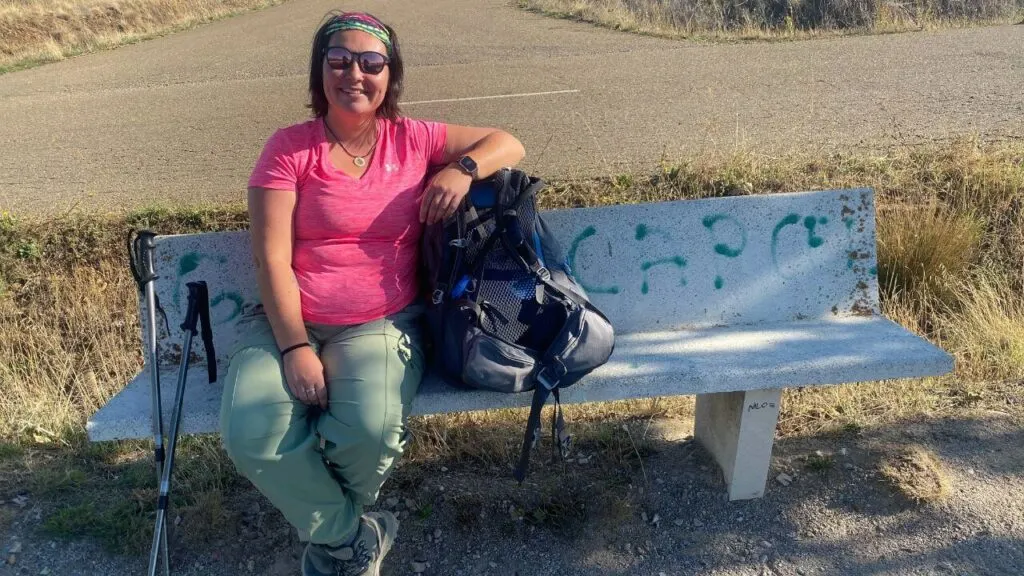
My friend posted about our entire trip so my friends and family could see too and she had a SIM card which most definitely came in handy. I did eventually give in and get a SIM card near the end but kept it on airplane mode while walking.
The decision to turn away from the “real” world gave me an opportunity to fully immerse myself in what I was currently feeling and working through. It was a challenge to slow down and not rush to the next destination day after day or pick up my pace when people passed me. I felt like I was losing, but it was such a clear comparison to how I rushed through life at home that I couldn’t help but notice the similarities.
My journey walking the Camino Frances was like a metaphor for my life. Everything I struggled with while walking, dealing with other people, and my own mental battles was just a microcosm of what I dealt with off of the Camino. Only focusing solely on the Camino gave me an opportunity to shift my perspective and deal with things face-on because I had limited distractions.
I opted to not listen to music or podcasts but I did give in for a few hours of Lizzo which gave me an extra spring in my step for that sunny afternoon of contemplation.
While walking I smiled a lot to myself, I challenged myself to sit on every bench I saw for a few days to encourage myself to slow down, I cried and abruptly stopped when I thought I heard someone near me. I ate a chocolate croissant nearly every day to the point where it became a thing and people would point out chocolate croissants to me whenever we entered cafes.
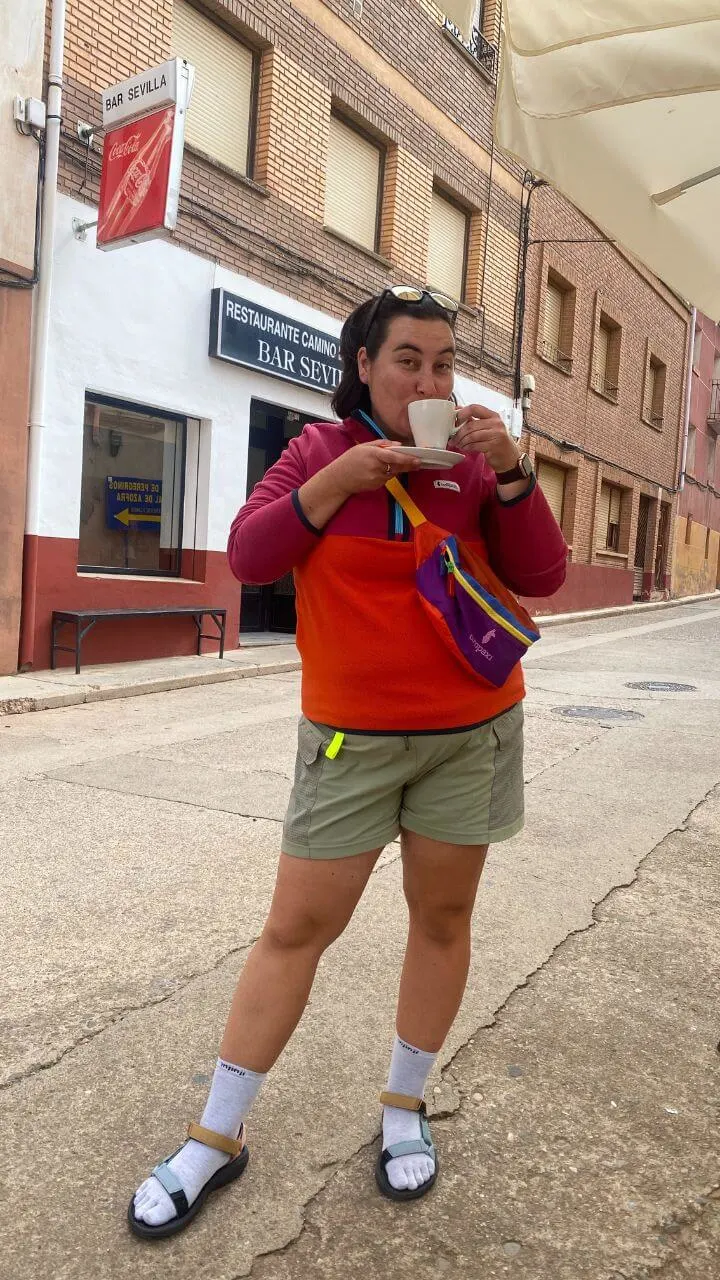
I learned to enjoy the sweet cafe con leches and savour my time sipping on coffee and just looking about with no computer to work on in front of me. I talked to strangers and listened to their heartwarming and heartbreaking stories. I rocked toe socks with my colourful Teva sandals, wore dirty clothes, developed a very toned butt, lost weight, worried about money, and left voice notes for myself of profound thoughts I had while walking.
I cursed at myself for choosing to walk 800km, for not speaking up when I needed time to myself, and for clinging too desperately to some people when I should have tried walking on my own. But I also thanked myself profusely for moments when there was nothing but the crunch of gravel beneath my boots and the warm sun on my arms. I was happy when I spotted my friend a few minutes behind me when I hadn’t eaten enough and felt like I was going to pass out. And I laughed out loud every time we saw the Happy Guy and he said “Be happy!” instead of “Buen Camino!”.
It’s really challenging to put into words just how profound of a trip walking the Camino can be and the characters you meet along the way. I was beyond proud of the physical aspect and finishing the walk, I loved how much I learned about myself and how much I grew, but I left disappointed that I didn’t feel or find more of a spiritual connection. Perhaps I anticipated it too much or held the idea up on a pedestal too high, but the last 100km, packed with pilgrims left me feeling as one lady put it, “It’s starting to feel like Disney World up in here.”
Regardless of any disappointment, there was much more good than bad. I laugh at the things that irritated me there now at how stupid they were. I got closer to my friend and spoke up more, communicating better and being more vulnerable. I was inspired by strangers who told me their traumatic stories and how they now thrive. And I left the Camino with a few clear answers to my questions: pivot to yoga, because it’s what I love to teach, something has to change or the anxiety will stay, and write the damn book.
The changes didn’t come immediately, but there has been a definite shift in my life for the better, and I’m still working on the book.
I met a girl on the Camino who gave up after less than a week. She explained to me at a cafe that she had no interest in going a step further. I couldn’t help but notice that she didn’t share her story. I knew nothing about her other than she was quitting and going to the beach. Most other people I met shared their stories. They opened up and let the Camino guide them to the answers that they were looking for.
I hope this inspires you to walk to the Camino (just in case you weren’t yet convinced) and to share your story because you never know who you will inspire and who will inspire you. Buen Camino, pilgrim.
Camino de Santiago Resources
You will find an abundance of resources to help to navigate your way on the Camino, these are the (useful) ones I used to prepare for my journey as well as while walking!
I used this app daily to find accommodation options and read reviews, know about cool places to stop or interesting facts about things I would be passing the next day, and for the downloadable map to make sure I never left the Camino path. If you only use one app, let it be this one. It is a paid app but well worth it. You can purchase the app for all Camino routes or for each one specifically.
Another app that I used daily, but this one is free. What I loved about Camino Ninja was the elevation map so I knew how much of an effort the walk each day was going to be and mentally prepare myself. It also provided good information about accommodation options and towns to stay in. The creator of this app was a dedicated individual to the Camino and he unfortunately passed in 2022, while I was walking the Camino. Last news I heard no one was sure what would happen to the app so please be mindful that not all information may be up to date.
Camigas: A Buddy System for Women On the Camino
While I was walking with a friend and wasn’t necessarily in search of a buddy to walk with, this Facebook group provided so much information to help me prepare for my trip. It got me pretty excited too and I loved reading through discussions. And it was so fun to spot others with the Camigas patches on their packs and know that they were a part of the community too!
This is by far the most helpful blog I came across while doing my research. They have thorough guides not only for all Caminos (which they’ve walked!) but for gear, tips, and honestly, anything you could need to know about the Camino. I never bought a guidebook as this blog provided ample information to prepare.
This website I found extremely helpful as well as I searched more about the Camino and what to expect. It almost always popped up during my search queries so I figured why not lead you directly to this incredible source.
A fair amount of my reservations along Camino Frances were done through Booking.com. This is also where I book by far the majority of my accommodation when travelling anywhere. Since you’ll be booking so many reservations in a short time you can also get access to discounts, which you must sign-up to begin collecting. Where possible I booked directly.
Camino de Santiago Books & Inspiration
The books that I read, enjoyed, and highly recommend! I read The Pilgrimage while I was walking the Camino and it was such a cool way to experience it. My list is short as I did read some others and found them to not be nearly as good as these.
- The Pilgrimage by Paulo Coelho
- What the Psychic Told the Pilgrim by Jane Christmas
- Steps Out of Time, One Woman’s Journey on the Camino, by Katharine B. Soper

